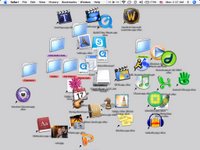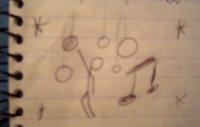Desktop Art Atrist's Statment
The desktop is an environment we interact with. We are spending a larger and larger amount of time on a computer doing things such as web browsing, talking online, listening to music, writing, and playing games. We spend our time not as much in room with a computer but more so in a virtual environment that we create, something comfortable for us. I sometimes think about how I can spend hours upon hours in a lab or at my desk and why do I not get bored. I hardly move or change position but yet I stay comfortable in the same place for hours. It has occurred to me that im not spending my time in a computer chair but rather a virtual world. Not a fictional world from a book or perhaps from a movie but rather a world that we created for our self to our own liking. In Vincent Ward’s film, “What Dreams May Come,” the main character, Chris dies and goes to his own personal heaven. His heaven is a world that he created, an environment to which he chooses and creates. This is a place he can spend an eternity in bliss. I, as like many others can spend such a long time in a virtual world because it is a world that we created, an ever-changing heaven. The computer desktop is a place we live in, play in, a virtual environment. We are represented by a cursor, an arrow and we open and close windows in order to explore the world we live in. Cursor is to us as desktop is to environment. One of my videos shows a cursor creating a world, exploring, and experiencing it. Windows and icons are objects in the world that the cursor interacts with. Other people represented by an icon, text, or image of their own choice enters the Cursors world via the Internet. This video will help people to realize the world that they emirs themselves in is a full environment that’s to be interacted with.
The Desktop is a mirror. A window holding a job resume can sit side by side to a window holding a song by Metallic. What’s on our computer screen can be a representation of our thought, it can reflect who we are, and what we do. Any given screenshot in time of someone’s screen is a self-portrait. It’s a collage of websites they visit, people they talk to, and music they listen to. A video will illustrate how a desktop becomes a self-portrait. The video will start with a clean non defying desktop. Things will be added piece by piece window by window until what on the screen defines a whole person. Every now and then during the course of the movie a piece of a face will appear in windows, backgrounds, game icons, in a video, on a website. By the end of the video not only will a person be represented by what’s on the screen, by also a visual representation of them will appear to re enforce the idea of a self-portrait. Shown after are fifty other self portraits, fifty desktops varying in operating system, programs, backgrounds, and icons. Each image has a name. The name for each is the name of the unknowing creator.
Desktops and computers have an increasingly bigger role in the world we live in. these pieces can be a prominent and poignant look at the world we are creating for ourselves. If we’re going to pick and move into an electric world we should be full aware of the environment that we choose. What we experience and how we experience it should be realized. The desktop seems to become more of a backdrop or a set to act in front of rather then a world we effect, control, and interact with.




